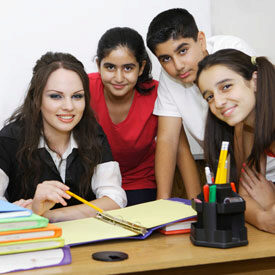Sherry Yang, 19, is a freshman at Wharton. In the summer of 2010, Yang volunteered with the Breakthrough Collaborative, an educational nonprofit that gives opportunities to gifted inner-city students. She came away with more life lessons than she could ever have hoped to teach.
My story is best told in vignettes. I remember a sweltering hot day in the middle of July when we took the students to Washington, D.C. On the way to the Air and Space Museum, Kenny, a teacher from Wesleyan University, opened the minds of the group to the idea of gravity as we walked the length of the national mall. They were so excited that they persuaded us to call the White House and leave a message for President Obama that conveyed their enthusiasm.
I remember how Aaron, a teacher from Haverford College, a known disciplinarian among his students, came to class one day in a pirate’s hat prepared to teach “arrrithmatic”. Alicia, from Columbia University, taught both a social studies and English section, which culminated in a city council debate about gun violence. Together the 8th grade physics and chemistry teachers taught phase changes by making ice cream and Oobleck (a substance created from corn starch and water that is both solid and liquid).
And I remember being in my class one day, looking at cells, and hearing the genuine “I love science!” that came from Kevin when he first looked into a microscope. Over the course of the summer I saw students open up and engage with others and find a home within Breakthrough. They considered global water issues and ate “real and raw” food courtesy of Lisa Maguire’s Get Real Get Raw local healthy foods nonprofit. Together we worked from 8 a.m. to 3:30 p.m. in rain and blazing heat. I believed that there was much to teach the students, and what I discovered was how much I needed to learn from them.
I was inspired by the minds of these middle schoolers and impressed by the Breakthrough Collaborative. The educational nonprofit is part of a larger network of sites in cities around the country and in Hong Kong dedicated to providing opportunities for gifted inner-city students. Middle school students undergo a rigorous selection process to participate in two years of enrichment programs and four subsequent years of high school and college counseling. During the six-week summer program, college students come to teach classes with their own lesson plans. The Germantown Friends School site, one of two Breakthrough sites in Philadelphia, brought together 80 students of various socio-economic backgrounds with 18 teachers from top universities.
Through talent show Wednesdays and poetry-reading events, I saw a larger issue that needs be addressed — the effect educational inequality at an early age has on confidence. The expectations students have of their futures narrow with each passing year when they are not challenged and sparked by new opportunities. As a student now at a university where all the opportunities in the world are available to me, it is all too easy to take for granted the feeling of having infinite possibilities within reach. I think about my students and remember that each opportunity is precious, because it may be one of few.
In Philadelphia, incoming high school students apply to public high schools. Differences in attendance, behavior and test scores can place a student in one of the best magnet schools in the city, or back into a neighborhood school where the chances of going to college drop exponentially. Breakthrough cannot provide a cure to these ills, but it can give students a community of support, a resource for the next journeys they undergo.
A good education brings people together, and that same good education divides people because those who have more knowledge are separated from those who have less. The ability to ignite a small spark in another person is powerful, and it can make all the difference in the world. It cannot shield a person away from the pain of other obstacles, but it can be enough to give purpose to the storm.
I saw that small spark in Sarah, a student in my science class. Sarah would call me every night, sometimes multiple times with earnest questions about the scientific method, punnett squares and natural selection. She pushed herself and, by the end of the summer, knew the material better than all her classmates. On the closing ceremony night, Sarah’s mother told me that whenever I was having a tough day, I should think of the impact that I made on her daughter’s life.
I learned this summer that motivation can get you inside a classroom, but once there you must learn how to actually teach and to accept that the impact you make may not always be seen –- ever, by your eyes. I have learned through my own experiences that it only takes one or two people to do something for you to believe that it is possible. So I continue on with that thought in mind, hoping that I can be a part of sparking possibility in others.
Related Links



